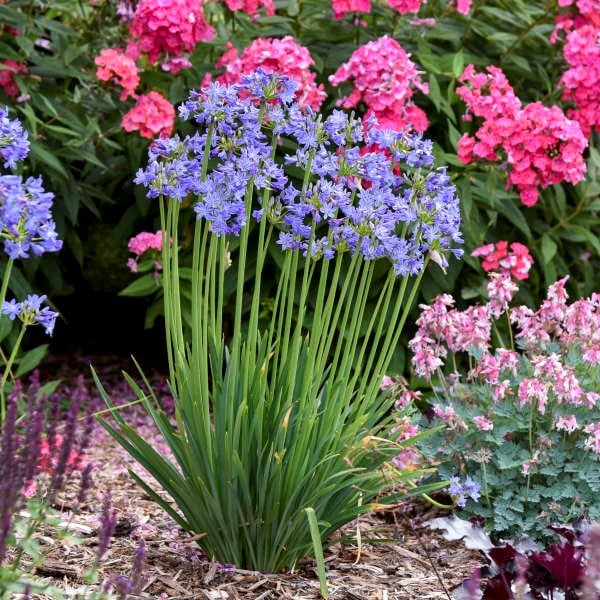Magnificent Agapanthus: Enhancing Your Garden's Appeal
Magnificent Agapanthus: Enhancing Your Garden's Appeal
Blog Article
Unleashing the Secret to Effective Agapanthus Farming: Idea for a Flourishing Garden
In the realm of horticulture, growing agapanthus effectively requires a tactical strategy that includes different facets of plant treatment. By recognizing the nuances of agapanthus farming, one can create an atmosphere where these plants grow and bloom generously.
Growing Agapanthus: Ideal Practices
When planting Agapanthus, appropriate dirt prep work is vital for making certain effective development and development of these lovely flowers. Agapanthus, typically understood as Lily of the Nile or African lily, grows in well-draining dirt with a slightly acidic to neutral pH level - Agapanthus. Before growing, it is important to amend heavy clay soils with raw material such as compost or peat moss to enhance water drainage and provide essential nutrients for the plants
To plant Agapanthus, choose a location that gets full sunlight to partial shade, as this will promote healthy growth and plentiful blooming. Dig an opening twice the size of the plant's origin round and position the Agapanthus at the same deepness it was formerly expanding. Delicately backfill the opening with dirt, weighing down strongly to get rid of any type of air pockets around the origins.
Water the freshly grown Agapanthus extensively and proceed to maintain the dirt equally wet, specifically throughout the plant's active growing period. Agapanthus. Using a well balanced plant food once a month can even more sustain the plant's development and flowering. By adhering to these ideal methods for planting Agapanthus, you can create a sensational screen of these fascinating blossoms in your garden
Ideal Dirt Issues for Agapanthus
For ideal growth and flowering success of Agapanthus plants, guaranteeing the soil problems are perfect is crucial. Agapanthus likes soil that is abundant in nutrients, so incorporating a well balanced plant food throughout the growing period can promote healthy and balanced growth and lively blossoms.

Watering and Fertilizing Tips
To guarantee healthy development and vivid blossoms, appropriate watering and fertilizing strategies are important for successful Agapanthus farming. Agapanthus plants profit from routine watering, especially throughout the growing season.
When it pertains to fertilizing Agapanthus, a well balanced plant food with equal parts nitrogen, phosphorus, and potassium can be used in the spring to advertise healthy development and blooming. Slow-release fertilizers are perfect for providing nutrients progressively over an extensive period. Prevent over-fertilizing, as this can bring about extreme foliage development at the expense of blossoms.
In addition, integrating raw material like compost right into the soil can improve nutrient degrees and improve dirt structure, assisting in the general wellness of the Agapanthus plants. By complying with these watering and feeding ideas, gardeners can guarantee their Agapanthus plants flourish and produce spectacular display screens of flowers.
Trimming and Deadheading Techniques
Appropriate pruning and deadheading methods play an essential role in preserving the health and looks of Agapanthus plants, complementing the necessary methods of watering and feeding for successful farming. Pruning Agapanthus entails removing invested blossom heads, yellowing or dead fallen leaves, and total shaping of the plant to advertise better development. Deadheading, the process of eliminating discolored blossoms, not only enhances the plant's appearance yet additionally encourages additional flowering.
When deadheading Agapanthus, it is suggested to snip off the flower stem at the base using sharp, clean shears. This procedure reroutes the plant's power from seed production back right into root and foliage growth, promoting a healthier and more robust plant. Routine deadheading can prolong the growing duration of Agapanthus and protect against self-seeding, which can lead to overcrowding.
In terms of trimming, Agapanthus generally gain from a light trim after blooming to tidy up the plant and encourage fresh growth. Cutting down the invested flower stems and eliminating any type of dead or damaged foliage aids keep the plant's vigor and overall look. Nonetheless, it is important to stay clear of reducing right into the crown of the plant, as this can weaken its health.

Protecting Agapanthus From Pests and Diseases
Implementing reliable bug and illness management strategies is critical to securing the health and wellness and vitality of Agapanthus plants in cultivation. Agapanthus are usually sturdy plants, but they can still drop sufferer to numerous pests and conditions otherwise correctly cared for. One usual pest that influences Agapanthus is the Agapanthus borer, a caterpillar that tunnels right into the plant, triggering damages to the leaves and blossoms. To stop infestations, regular inspection of the plants is necessary. If borers are discovered, they can be by hand eliminated, or insecticidal soap can be used as a control step.
In addition to parasites, Agapanthus are vulnerable to diseases such as origin rot and fungal leaf spots. These problems can commonly be stopped by ensuring appropriate water drainage and avoiding overwatering. Influenced useful site components of the plant need to be quickly eliminated to protect against more spread if signs of illness appear. Fungicides may additionally be made use of as a treatment measure, complying with the maker's instructions carefully. By staying alert and attending to bug and condition concerns without delay, gardeners can help their Agapanthus thrive and prosper.

Conclusion
Finally, successful cultivation of agapanthus calls for appropriate planting methods, optimal dirt problems, appropriate watering and fertilizing, normal pruning and deadheading, and protection from diseases and bugs. By adhering to these techniques and pointers, gardeners can ensure a growing yard loaded with beautiful agapanthus flowers. Agapanthus. Bear in mind to maintain regular care and focus to detail to advertise the health try this site and durability of these stunning plants
When planting Agapanthus, correct dirt prep work is vital for making see this here certain successful development and growth of these stunning blossoms.Water the recently grown Agapanthus extensively and proceed to maintain the dirt equally moist, especially during the plant's active growing season.For ideal growth and flowering success of Agapanthus plants, making sure the dirt problems are suitable is crucial. When transplanting or planting Agapanthus, ensure the soil is well-prepared to supply the essential foundation for the plants to establish themselves effectively. One typical parasite that influences Agapanthus is the Agapanthus borer, a caterpillar that tunnels into the plant, causing damage to the blossoms and fallen leaves.
Report this page